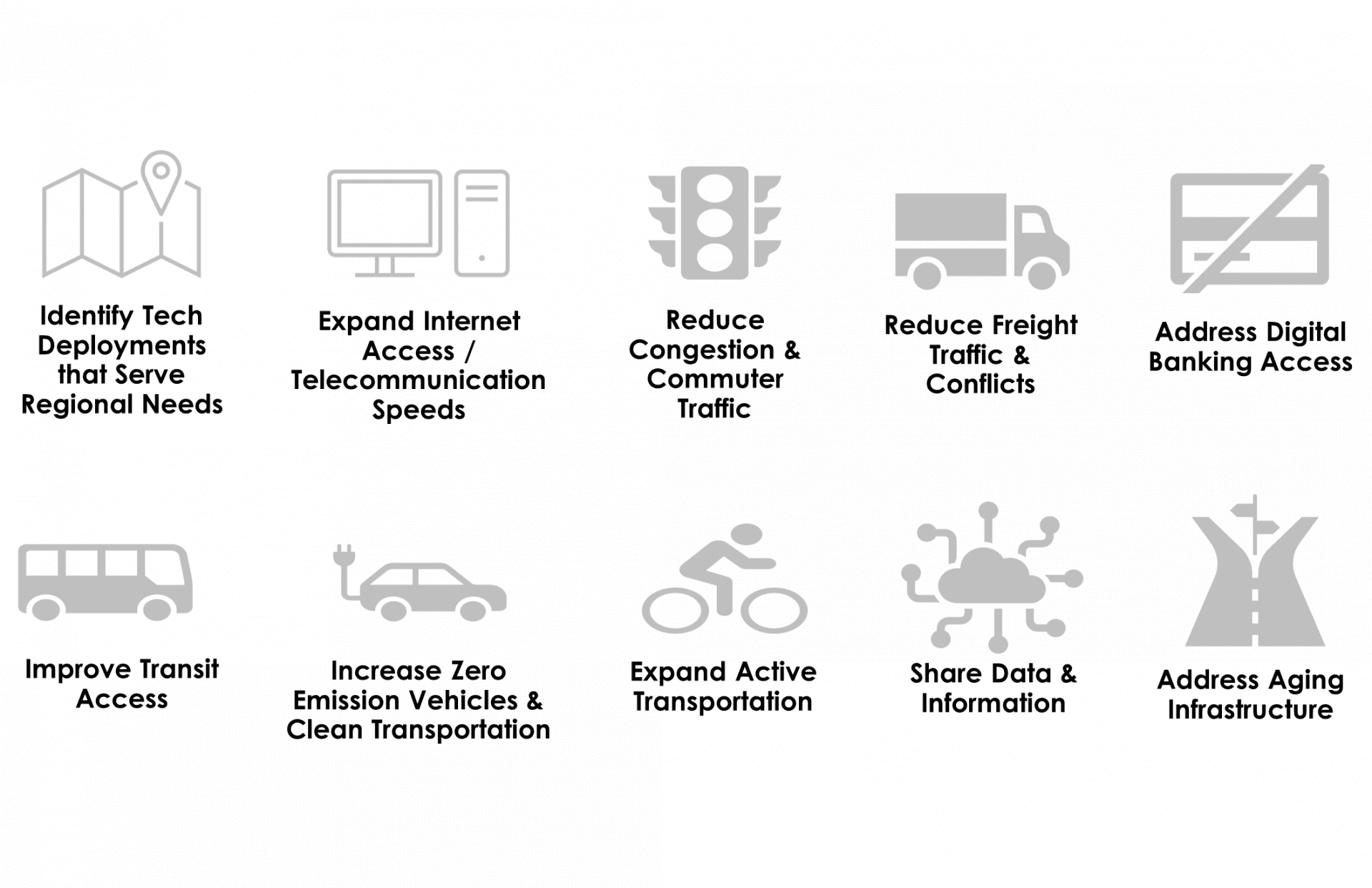July 12, 2021
What San Joaquin Council of Governments Learned Through Their Transportation Innovation Study
Keeping a community moving doesn’t always mean enhancing roads, bike lanes, or sidewalks. The most impactful innovation that the San Joaquin Council of Governments (SJCOG) discovered through their Transportation Innovation Study is one that might not be commonly associated with transportation, but will set up SJCOG to meet their communities’ pressing needs long term. The work of SJCOG over the past few years and the steps they’re taking to expand their fiber optic communication network is a strong example to other communities looking to combat challenges with commuting, congestion, and technology in transportation.


Context of San Joaquin County
The San Joaquin region, comprised of the cities of Stockton, Lodi, Manteca, Tracy, Ripon, Escalon, Lathrop, and County of San Joaquin, is situated in northern California, east of Silicon Valley. In addition to being a prominent agricultural and logistics center, the San Joaquin region is home to many employees of Silicon Valley companies who seek to avoid the Bay Area’s skyrocketing cost of living.
Prior to the COVID-19 pandemic, the San Joaquin region was dealing with heavy congestion as more and more commuters moved into the valley and made the daily trip over the Altamont Pass to work in the Bay Area. Concerned about the increasing congestion and aware that emerging transportation technologies will also impact commute behaviors, SJCOG launched a Transportation Innovation Study to understand how they could best prepare for transformational technologies and set themselves up for a resilient future.
Though SJCOG initially launched the study with congested commutes in mind, the communities across the San Joaquin region are starting to experience the challenges of “Zoom towns,” a newly coined term that describes communities experiencing a population boom due a rise in teleworking and even online college courses. Throughout the study, we focused on the region’s needs for reducing congestion, improving resiliency, and serving the changing behaviors of commuters considering the pandemic and what these changes may mean for the region.
Applying NCHRP Report 924 to Move the San Joaquin Region Forward
At Kittelson, we’re all about solving the unique challenges that come with planning for future transportation technologies. We were excited to collaborate with SJCOG to apply the self-assessment framework of NCHRP Report 924, “Foreseeing the Impact of Transformational Technologies on Land Use and Transportation”, which we wrote to help public agency decision-makers plan for the future in the midst of rapidly changing technology.
The most successful ingredient of SJCOG’s Transportation Innovation Study was the strength and engagement of a working group that included agency staff, private industry, academics, and local business development and community advocate groups. This working group provided an informative picture of the needs and challenges of the region that put SJCOG in a strong position to identify solutions.
First, we worked to understand the region’s greatest transportation challenges-which included a quickly growing population, heavy peak hour congestion, and a lack of technology infrastructure to support advanced traffic management.
Then, we got into brainstorm mode. We talked about everything from high-speed rail and automated vehicles to connected technology that would help trucks and cars safely share the road with low-speed farm equipment. For each promising idea, we developed summary sheets detailing the components, cost, timeline, description, and funding opportunities. We took these potential projects to the working group to understand the best and most feasible options for the varied communities of San Joaquin County.

Some projects were checked off the list for good reason: SJCOG was already doing them! These included an integrated fare payment system, mobility hubs with electric vehicle charging infrastructure, a partial transition to an electric bus fleet, an on-demand rideshare service, and a future micromobility service-none of which is easy to pull off. The fact that SJCOG was already moving these efforts forward meant we could focus our recommendation on a key infrastructure project that would have far-reaching impacts on transportation and community needs.
To advance transportation innovation in the region, we recommended SJCOG support the expansion of the fiber optic communication network. By leading a county-wide fiber readiness assessment, SJCOG will help its local jurisdictions take action to expand their networks.
Fiber Optic Network Expansion
Expanding the fiber network in the county is fundamental to implementing the region’s congestion management strategies, advancing the Internet of Things (IoT), and supporting business and home internet connectivity.
From a transportation perspective, the build-out of a fiber optic network creates the backbone of advanced traffic management systems, Intelligent Transportation Systems, and connected vehicle technology.
A strong fiber network can also improve access to jobs, education, healthcare, and logistics for residents and employers in San Joaquin County. Currently, 61% of San Joaquin’s rural population doesn’t have access to a single internet service provider offering 100 Mbps speed (the FCC’s recommended download rate for general household internet access).
High-speed internet access makes it possible for residents to telework effectively and makes the communities of San Joaquin County more desirable for companies to set up satellite offices where their employees live.

A strong fiber network can improve access to jobs, education, healthcare, and logistics for residents and employers, and it creates the backbone of advanced traffic management systems, Intelligent Transportation Systems, and connected vehicle technology.
Fiber City Checklist
SJCOG is implementing the fiber network expansion recommendation from the Transportation Innovation Planning Study, and hired Kittelson and AECOM to conduct a Fiber Readiness Plan. We will conduct an existing inventory assessment, a review of local utility policies, and identification of opportunities to streamline utility permitting. Although fiber expansion is outside of SJCOG’s authority, this readiness plan is the critical first step to help the local jurisdictions prepare for public-private partnerships with telecommunications providers.
Takeaways for Other “Zoom Towns” Analyzing Their Transportation Needs
Here are a few key lessons learned from this project that other rapidly growing rural communities may benefit from:
- The way we analyze transportation needs and impacts is changing. Technology not only impacts the modes we choose, but it can also change (and even remove) a trip purpose. We must consider transportation in the context of other forms of technology in a community.
- Infrastructure includes internet access. After a volatile 2020 and 2021, rural areas are experiencing the challenges of growth through increased teleworking, and they are making a concerted effort to pursue infrastructure that supports high-speed internet access. We are also seeing this recognition federally with new grants for communities.
- Fiber optic networks are a foundational element of Intelligent Transportation Systems (ITS). ITS technologies help advance transportation safety, mobility, and efficiency by integrating advanced communications capabilities into transportation infrastructure and vehicles.
- In many ways, SJCOG is representative of the evolution of transportation that’s happening across the country, and we have a lot to learn from their approach to these projects. Planning around changes in teleworking and commuter behavior while faced with outdated infrastructure is daunting. Through a thoughtful and methodical approach, agencies can pursue grant opportunities and form partnerships to bring about change one step at a time.
We’d be happy to talk through this project, and our approach to it, further. Reach out to us!
- Abby Morgan, Senior Engineer
- Rachel Grosso, Planner
- Matt Braughton, Associate Planner
